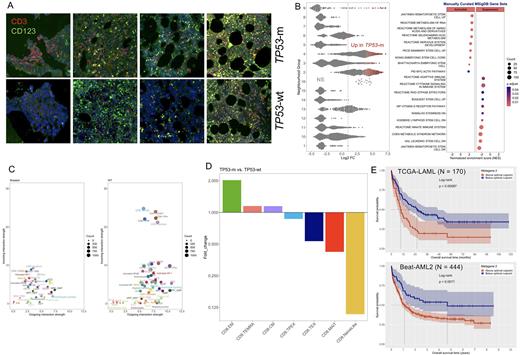Introduction
Somatic TP53 mutations and 17p deletions with genomic loss of TP53 occur in 8% to 10% of AML and correlate with primary induction failure, high risk of relapse, and dismal prognosis. We have previously shown that TP53 abnormalities are associated with a pro-inflammatory and immunosuppressive tumor microenvironment (TME), including high CD274 and FoxP3 expression, with dysfunctional natural killer (NK)/CD8 + T-cell states and with response to flotetuzumab, a CD123 × CD3 bispecific T-cell engager. In the current study, we explore the cellular neighborhoods of TP53-mutated ( TP53-m) AML using spatially resolved transcriptomics and we employ machine learning to identify prognostic RNA signatures.
Methods
We analyzed the expression of >1,800 immune and TME genes in bone marrow (BM) formalin-fixed paraffin-embedded (FFPE) sections (5-µm) from a discovery cohort of 11 patients with chemotherapy-naïve AML (N=5 TP53-m and N=6 TP53-wt cases) using the GeoMx™ Digital Spatial Profiling (DSP) platform (Cancer Transcriptome Atlas with next generation sequencing read-out; NanoString Technologies, Seattle, WA). Imaging was performed at 20× magnification and a total of 151 circular regions of interest (ROIs) with a 300-600 µm diameter were selected (Fig. 1A). We then generated a ROI-by-gene count matrix for deconvolution and downstream pathway analysis. For each ROI, enrichment scores reflecting immune senescence/dysfunction and leukemia stemness were calculated with gene set variation analysis (GSVA), using a manually curated compendium of published gene signatures as input. We also employed public bulk and single-cell RNA-sequencing (sc-RNA-seq) AML cohorts for in silico modeling and validation.
Results
We initially captured transcripts from ROIs of TP53-m and TP53-wt AML with varying degrees of BM infiltration with T cells (CD3 hotspots) and AML blasts, and we found that TP53-m is enriched in T cell-specific, type I/II interferon (IFN) and pro-inflammatory genes ( IL1B), as well as leukemia stem cell (LSC)-related gene programs (LSC17). After dichotomizing ROIs based on a median split of CD3D RNA expression, we observed that T-cell low ROIs express higher levels of monocyte-macrophage and myeloid derived suppressor cell (MDSC)-related genes, including S100A9 and S100A8. These findings point to previously unappreciated links between BM infiltration with immune-modulatory myeloid cell types and leukemia stemness / T-cell abundance. We then tested for differential cell density in neighborhoods (regions of transcriptionally similar cells) across TP53-m and TP53-wt AML using MiloR in a sc-RNA-seq AML dataset annotated by cell type (N=42 cases, of which N=3 with TP53-m; Lasry A, et al. Nat. Cancer 2023). This orthogonal approach highlighted a significantly higher frequency (FDR <0.05) of multipotent and granulocyte-macrophage progenitor neighborhoods in TP53-m AML, alongside suppression of adaptive immune system pathways (Fig. 1B). We next inferred active receptor-ligand pairs mediating the crosstalk between T cells and leukemic blasts in the TME of TP53-m AML, and we uncovered decreased MHC class I/II-mediated signaling, curbed CD8 +/CD4 + T cell-to-AML interactions and enhanced CD6/ CDCP1( CD318) signaling (Fig. 1C). We also found that CD8 + and CD4 + T cells from TP53-m AML are enriched in effector memory (T EM) / terminally differentiated effector memory (T EMRA) and regulatory T-cell gene programs, respectively, compared with their cellular counterparts from TP53-wt patients (Fig. 1D). In particular, T EM cells from TP53-m AML expressed genes known to regulate T-cell dysfunctionality, foremost PRDM1, and transcription factors ( ZEB2) expected to drive the differentiation of killer cell lectin-like receptor (KLR) + exhausted T-cell states with residual cytolytic potential. Finally, we applied the least absolute shrinkage and selection operator (LASSO) statistical method for feature selection to our discovery AML dataset, and we constructed a TP53-m-related ‘spatial metagene’ that predicted poor overall survival in TCGA-LAML (N=170) and Beat-AML2 cases (N=444; Fig. 1E).
Conclusions
Spatial gene programs of leukemia stemness, T-cell dysfunction and immune suppression are enriched in TP53-m AML. It remains to be determined whether TP53-m AML with a pre-existing but ineffective T-cell response may be amenable to T cell-targeting immunotherapies.
Disclosures
von Bonin:Novartis: Other: Advisory Board; BMS: Other: Advisory Board; Janssen: Research Funding; Kite: Other: Advisory Board. Zeiser:MNK: Consultancy, Honoraria; Sanofi: Consultancy, Honoraria; incyte: Consultancy, Honoraria; novartis: Consultancy, Honoraria, Research Funding; Medac: Honoraria; VectivBio: Consultancy.


This feature is available to Subscribers Only
Sign In or Create an Account Close Modal